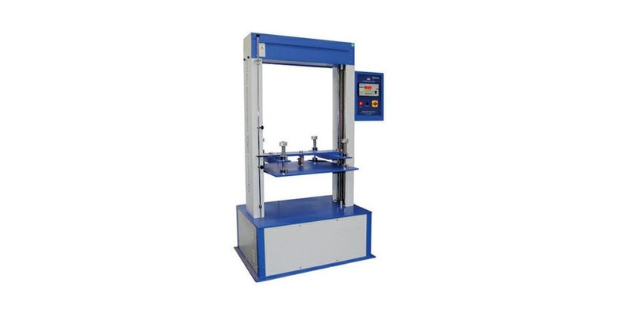Universal Tensile Machine (UTM Machine) Suppliers

Introduction
Tensile strength is applied to raw materials or parts using a tensile testing machine, also known as a universal testing machine (UTM), to evaluate both tensile and compressive force. It is frequently used for both small- and large-scale load testing in quality control and research projects.
Product Description
Universal Tensile Testing Machine (Tensile/elongation/load Tester)
UTM is a fundamental instrument for polymer manufacturers to determine sample strength, elongation, flexibility, and physical and mechanical behavior. ASTM D 638, D 882, D 790, D 695, and BS 2782, as well as numerous other comparable standards.
Test Can Perform: Tensile, Flexural, Compression, Peel, Bond, Cyclic.
A tensile Testing Machine is used to accurately measure a material's standing force capacity by pulling it apart and determining how far the material is stretched before breaking.
IDEAL LAB EQUIPMENTS LLP UTM provides highly accurate results using cutting-edge technology and is available in various models for testing a wide range of materials. Load Measuring Sensor, Sample Holding Grips, and Fixtures are interchanged to perform various tests such as compression, flexural, TENSILE, peel strength, and bond strength.
UTM Machine Controller And Software Features
Electronic Controller Features
- Microcontroller-based intelligent unit.
- Both direction compression/ elongation motor movement.
- Display both load & displacement.
- Manual operation of Home, Up & Down movement of the jaw.
- Load resolution 0.01% (one count in ten thousand counts).
- Length resolution minimum 0.1mm.
- Auto report generation with all the load-related parameters.
- RS-232 interface (For Computer Operation).
- Input Power 230v, 50 Hz,1 Phase.
Software Features
- Printing Of Final Report On Computer – With Graph For Load Versus Length Or Graph For Strain Versus Stress.
- Display Of Peak Load, Calculation Of Peak Strength.
- Selection Of Sample – Type – Flat, Circular, Tubular Or Odd For Area Calculation.
- Selection Of Test Type – For Elongation Or Compression, flexural, Tensile, Peel Bond, Cyclic.
- User Defined Sample Creation – With User Defined Name And Batch Number For The Samples.
- Online Display Of Graph – When The Test Is On.
- Tabular Data Reporting Of Samples – With Calculation For Mean And Standard Deviation.
Certification: Calibration Certificate With Nabl Traceability For 1 Year.
Warranty: 1 Year Warranty.
Additional Features
Compact table-top design.
Performs tension, compression, peel and bend tests.
Tests with high elongation materials surpass ASTM and ISO precision requirements
when choosing between several speeds using a pulley belt system.
Possibility of mounting various load cells.
A place where you can climb different grips and test fixtures made of leather, plastics, rubber, paper, cables, metals, and plywood.
Applications
Tensile Testers are used to evaluate the mechanical properties of various polymers. It is essential since it calculates most mechanical loading and properties such as tensile strength and modulus, elongation, compressive strength, etc.
Note: Ideal Lab is the finest Universal Tensile Machine Manufacturer and Supplier in Mumbai. We offer Universal Tensile Machines to our clients at a lower price.
What is a UTM Machine?
A UTM apparatus, also called a UTM tester, lab machine, or material testing frame, determines materials' tensile and compressive strength. The "universal testing machine" is the name given by the manufacturers. Mechanical characteristics like tension, tensile, compression, and transverse stresses may also be mechanical. The peel test, flexural test, tension test, bend test, fiction test, spring test, and others are further tests. Numerous UTM machine functions have had portions of their capabilities removed or sold for use in particular industries and sectors crucial to developing roads, highways, and other forms of infrastructure.
Ultimate Tutorial on How To Use A Universal Testing Machine.
A materials testing device is a universal testing machine or UTM. The machine is widely utilized in the manufacturing industry for various purposes. To evaluate the tensile and compression strength of metallic and non-metallic materials, a universal testing machine (UTM) is typically utilized.
This Ultimate tutorial will help you grasp a UTM's fundamental principles and operation, as well as its construction, sample preparation, and application for tensile and compression testing.
Utm Construction And Operation
There are two basic components to a universal testing apparatus.
- Loading Unit
- Control Unit
Loading Unit
The following elements make up a UTM's loading unit:
- Load Frame
- Upper Crosshead and Lower Crosshead
- Elongation Scale
Load Frame
A universal testing machine's load frame is constructed using one or two supports. The load Frame comprises the upper crosshead, lower crosshead, and table on which the specimen is placed during the compression test.
Upper Crosshead and Lower Crosshead
One end of the test specimen is clamped using the top crosshead. The lower crosshead is the moveable crosshead in the load frame, and it can be raised or lowered by loosening and tightening its screws. Each crosshead has a tapered slit in the center. This slot has a set of racking jaws that are designed to grip and retain the tensile test specimen. The crossheads in certain versions are operated by a separate power pack and have hydraulic jaws.
Elongation Scale
The lower and higher tables' relative displacement is measured using an elongation scale included with the loading unit.
Control Unit
The primary parts of a universal testing machine's control unit are
- Hydraulic Power Unit
- Load Measuring Unit
- Control Devices
Hydraulic Power Unit
This unit comprises an oil pump that delivers non-pulsating oil to the load unit's main cylinder. This flow facilitates the application of load to the specimen. An electric motor and radial piston pump drive the oil pump in a hydraulic power unit.
Load Measuring Unit
This device contains a pendulum dynamometer with a tiny cylinder containing a piston that moves with the non-pulsating oil flow. A pivot lever connects the pendulum to the piston. The load on the specimen causes the pivot lever to deflect. This deflection is transformed into a load pointer and displayed on the dial as the load. In some types, pressure transducers are installed on the machine, and the feedback from the transducers is sent to an electronic panel for accurate load measurement.
Control Devices
There are hydraulic and electric control systems available. Electric control devices use switches to turn on and off the machine and adjust the crossheads. The two valves that comprise a hydraulic control mechanism are the Right Control Valve and the Left Control Valve, also known as the Release Valve. An appropriate control valve is used to apply load on the specimen. The load application is released using the left control valve.
Sample Preparation for UTM
Sample preparation varies depending on the purpose of testing. In the general scenario, however, samples are cut in the shape of a dumbbell, with the shoulders of the test specimen kept broad compared to the testing area.
Tensile Specimens
Only a few of the numerous options for testing to this standard include bars, tubes, sheets, pin-loaded specimens, spherical specimens, and powdered metallurgy products. In contrast, the most frequent example is a rectangle with a gauge length of 50 mm and a width of 12.5 mm. According to the standards, the gauge length should be five times its diameter.
UTM for Various Testing
UTM is primarily used to test the mechanical characteristics of materials. The standard tests performed by UTM are:
- Tensile Test
- Compression Test
- Peel Tests
- Bending Test
UTM for Tensile Test
Clamp a portion of the specimen to each end and pull it apart until it breaks. It determines how robust (tensile strength), elastic (elongation), and stiff it is (tensile modulus).
UTM for Compression Test
A tensile test's inverse. Crushing a thing between level plates until a certain load or distance is attained, or the product breaks. The most used measurements are compressive force, load at displacement (55 pounds at 1" compression), and displacement at load (0.24" of compression at 20 pounds of force). The compressive force is the maximum force that may be applied before breaking.
UTM for Peel Test
The same as a tensile test. Instead of separating a single component, you separate two materials bound together. In this test, one clamp holds one material and the second clamp holds the other materials. You then push them apart a few inches. The "average peel force" is the average of all force readings taken throughout the test, which can measure the force up to 1000 times per second.
UTM for Bend Test
It is a compression test in which a length of material is supported by spanning it across two supports on each end. Nothing underneath it supports the middle section. Then, from above, press down directly in the center of the material span until the supported material breaks or reaches a certain distance. This test determines how stiff a material is and how strong it is in flexure (flexural strength) (flexural modulus).
